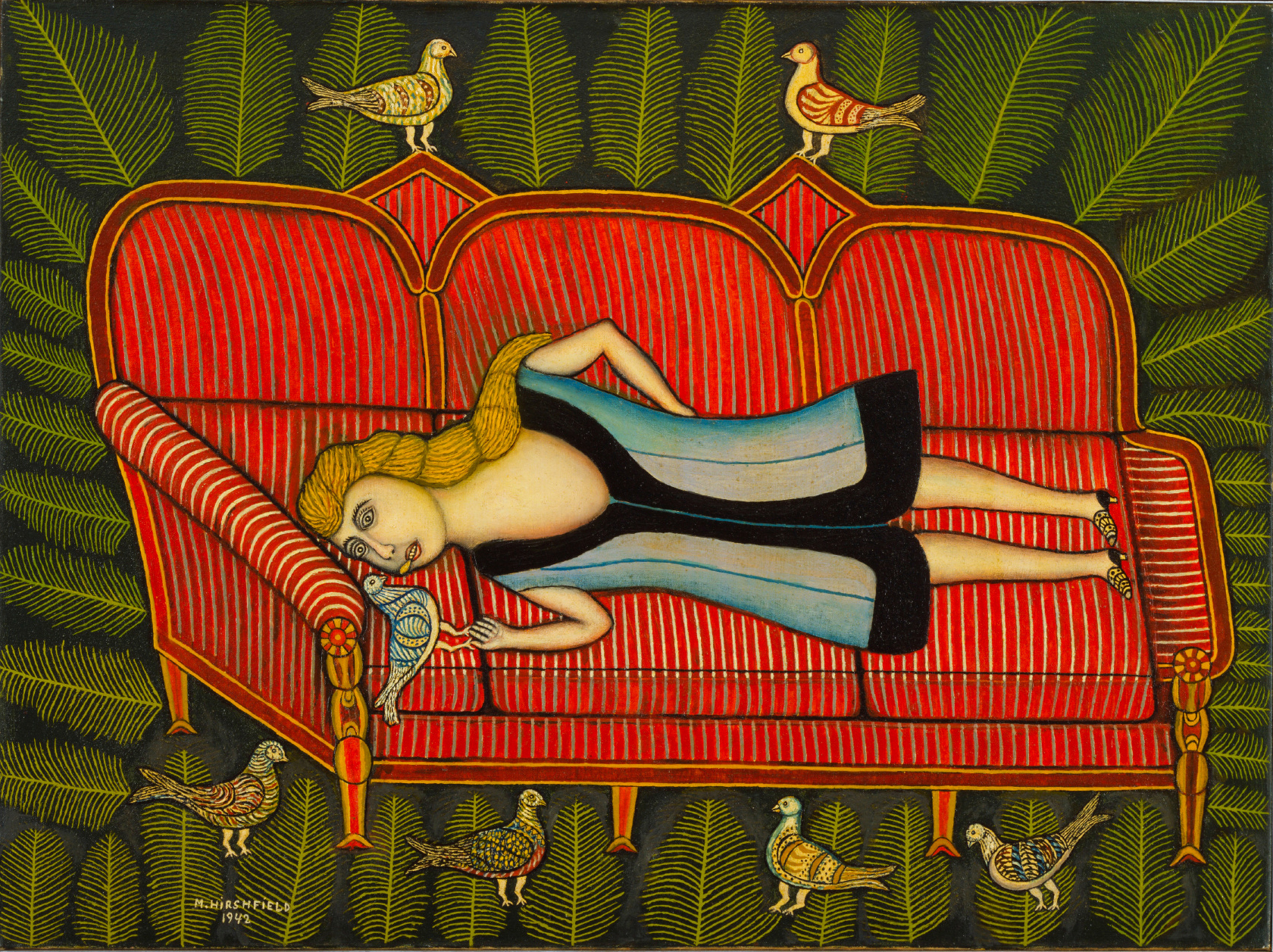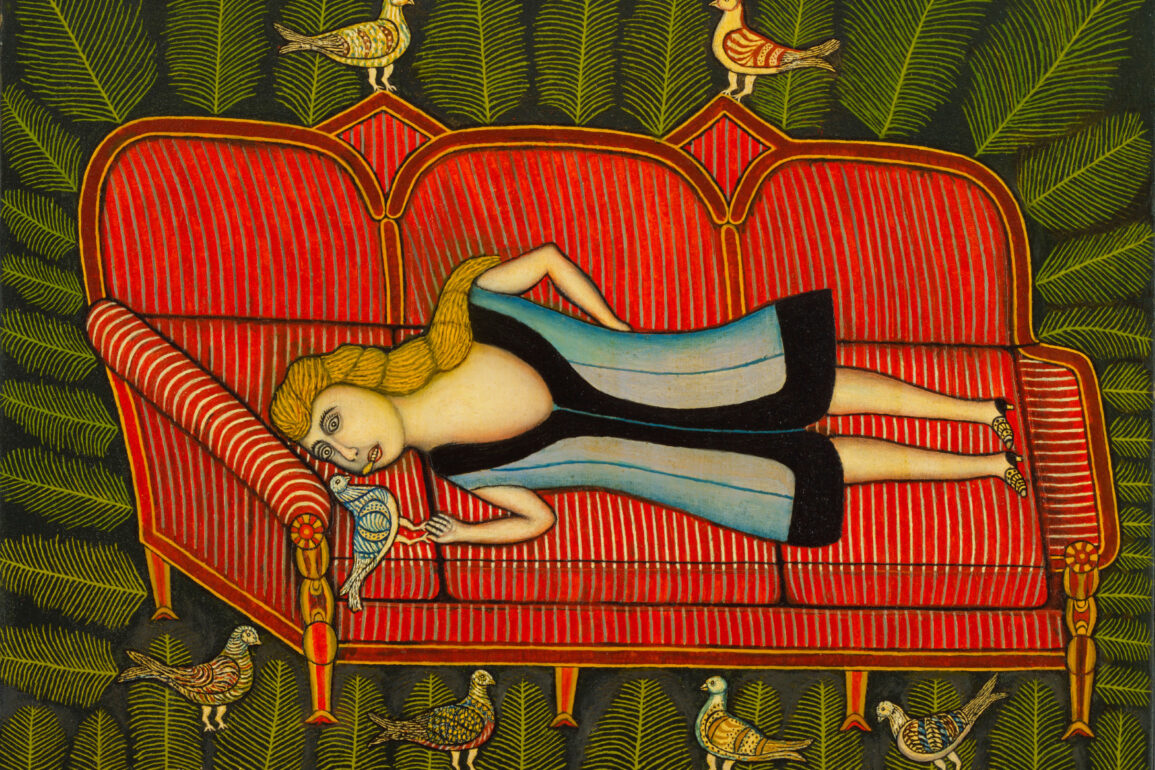
Morris Hirshfield’s life seems, at first glance, to be the stuff that inspires biopics: Polish immigrant starts out in the garment industry of New York City, later owns his own tailoring business then shoe store, earns patents for his footwear designs only to lose it all in bankruptcy. But, in true cinematic style, he then finds success in retirement as an artist whose very first paintings are featured in an exhibition at the Museum of Modern Art. Seems improbable, maybe even impossible? It is a fascinating story that is well told and illustrated in the exhibition, “Morris Hirshfield/Rediscovered,” on view through Jan. 21, 2024 at the Cantor Arts Center.
The reason you may have never heard of Hirshfield (and why he has been “rediscovered”) is that, after that initial success, he was largely forgotten in American art history, even though his paintings are in the holdings of such prestigious institutions as the Metropolitan Museum of Art in New York City. That is where Dr. Richard Meyer, professor of art history at Stanford University, had his first encounter with a Hirshfield painting. It would lead to a 10-year journey of research and discovery that resulted in a book and then an exhibition.
“I had heard of Hirshfield before, but I had never seen one of his paintings in the flesh,” said Meyer. His reaction was immediate: “This man’s work deserves to be seen.” Meyer also shared that it was the first time he was motivated by a work of art, rather than a movement or theory. He and colleague Susan Davidson set out to find as many paintings by the artist as possible, in order to fully tell the story of a self-taught artist who enjoyed a brief period of acclaim, only to fall into obscurity.
The exhibition, the only full-career retrospective of Hirshfield’s work, begins with two paintings of houses (“Landscape with House I” and “Landscape with House II”). From afar, they might appear to be examples of Early American embroidered samplers. A closer look, however, reveals that the artist created the appearance and texture of woven materials in paint. Meyer refers to this as the “textile imaginings” that are a hallmark of all of Hirshfield’s work.Not surprising, noted Meyer, because, “He taught himself how to cut patterns, to sew and tailor. He is bringing his creativity from other sources.”
Fanciful creativity abounds in all of Hirshfield’s work, whether the subject is portraits, animals or nudes. What is absent in his work is the technical polish of an academically trained artist. There is no attempt at anatomical correctness or proportion; space is flattened and there is no effort at spatial perspective. Hirshfield’s figures seem to float against backgrounds of colorful patterns and textures
“This is the world he saw in his mind’s eye; the world he wanted to get down on canvas. It was an internal reality, not an external one,” Meyer said.
Hirshfield, who never used live models and worked from his home in Queens, expressed this reality in paintings like “Harp Girl II.” A woman stands inside a golden harp, which is richly embellished with designs in contrasting red and black, against a blue background dotted with golden stitch-like strokes. She is rendered in the most simplistic manner, facial features not clearly delineated, but her blue and yellow checked skirt has been meticulously drawn
In “The Artist and His Model,” there is a distinct dream-like quality to the scene. Hirshfield portrays himself as a young man with dark hair and mustache, standing beside his red-haired model who is posed on a colorful platform. Her body is drawn in a generalized manner and both of her feet turn to the left, a quirk of Hirshfield’s that caused critics to dismissively refer to him as “the master of two left feet.” (This is also the title of Meyer’s book, an accessibly written and well-illustrated tome that fully details Hirshfield’s life.)
It was this naïve yet uniquely stylized approach that captured the attention of Sidney Janis, a well-known gallerist in New York. He was mainly responsible for Hirshfield’s acceptance and rise to fame in the art world and most of the paintings in this exhibition are on loan from the Janis estate. Because Hirshfield gave no interviews (Meyer theorized that, “The art world was not a comfortable place for Morris Hirshfield”) Janis was able to create a persona that, for a while, appealed to museums and to avant garde artists like the Surrealists
One section of the exhibition is devoted to “The First Papers of Surrealism,” a 1942 exhibition curated by Andre Breton that boasted such luminaries of the movement as Miro, Mondrian and Tanguy. Hirshfield, the only self-taught artist in the group, was included because of his original and unspoiled approach. In “Girl With Pigeons,” the Surrealist penchant for dream-like narratives that juxtapose unlikely objects in an effort to explore the unconscious mind is apparent. A woman lies across a richly patterned sofa set against a background of green palm fronds that completely surround her. Six colorful pigeons pause in stillness above and below her, while one appears to inexplicably peck at a treat she holds between her lips. This is just the sort of other-worldly incongruity that the Surrealists loved and pursued in their work.
“You can’t understand self-taught art as completely separate from modern art,” Meyer said. Hirshfield, he believes, serves as a bridge between the self-taught and the Surrealist artists. He points out that Hirshfield was never referred to as a “folk artist” (there is a small section in the show devoted to this group) like Grandma Moses because “he worked in complete isolation and his art did not reflect his community.”
Perhaps it was because of this independence and the fact that he could not be easily categorized that Hirshfield enjoyed a brief five-year period of success and acclaim. Janis showed his work in his gallery and succeeded in securing Hirshfield a solo exhibition at the Museum of Modern Art in 1943. That show, which included 30 paintings created from 1939 to 1943 (the crux of his career), was critically received.
So why has the artist been largely forgotten? “In art history everything is a progression toward abstraction,” explained Meyer. “Morris Hirshfield doesn’t fit.”
Morris Hirshfield died in 1946 and most of his life’s work (an estimated 78 paintings) was relegated to museum storage or collectors’ living rooms – until Richard Meyer became “captivated by his story and his art works.” This exhibition was presented last year at the American Museum of Folk Art in New York City and Meyer’s book was recognized with the 2023 Dedalus Foundation Exhibition Catalog Award
“I hope that this exhibition will be a spark to discover other stories,” said Meyer. “Morris Hirshfield’s life is a complicated and unique story but the aspirations to advance in American culture are universal and relevant today.”
“Morris Hirshfield/Rediscovered” is on view through Jan. 21 at the Cantor Arts Center, 328 Lomita Drive, Stanford. Admission is free; reservations required. For more information, visit museum.stanford.edu.
The Cantor is hosting additional events related to the exhibit, including a discussion with Hirshfield’s grandson Robert Dennis Rentzer and exhibition curator Richard Meyer on Sept. 28, 6-7:30 p.m. (RSVP via eventbrite.com); “Threading History,” a discussion on Jewish Americans and the garment industry on Nov, 9, noon-1:30 p.m. (RSVP via Google Forms) and a curator talk with Richard Meyer on Nov. 16, 12:30-1:30 p.m. (RSVP via eventbrite.com)
This post was originally published on this site be sure to check out more of their content.







